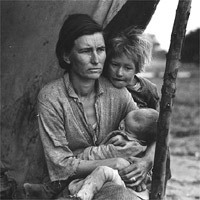 |

這場大崩盤影響了每一個人,有些人 (例如農夫) 受到的影響程度又更大

|
 |
|
 |
股票市場在經濟大蕭條時跌到歷史最低點
1932年7月8日
喬治‧瑪哈列司 (George
Mehales) 在1929年的股票市場崩盤中失去一切,包括他的餐廳。他說:「1929年10月的第一天讓我覺得我很富有,然後我徹底完蛋了,我什麼都沒有了。」瑪哈列司是一個住在南卡羅萊那州的希臘移民,他是許多想趁著1920年代經濟快速成長大賺一筆,但是又沒經驗的投資人當中的一個。股票市場可以是很好的投資管道,但是風險也很大,尤其是當你對股票瞭解不深,就得負擔更大的風險。
股票大崩盤 (Great
Crash) 影響了每一個人的生活,就連那些沒有買股票的人也無法倖免。人們跑到銀行把存款提出來,因為他們擔心銀行會賠掉所有的錢。
George Mehales lost everything in the stock market crash of 1929, including his restaurant. "The first day of October in 1929 made me feel like I was rich . . . (then,) I was wiped out . . . I had nothing left." Mehales, a Greek immigrant who lived in South Carolina, was just one of many inexperienced investors who hoped to get rich quick in the rapidly growing market of the 1920s. The stock market can be a good place to invest some of your money, but it is also risky, especially if you do not know much about stocks.
The Great Crash affected everyone, even those who had not bought stocks. People ran to their banks to get their savings, fearing the banks would run out of money.

 1/3 頁
1/3 頁

|





